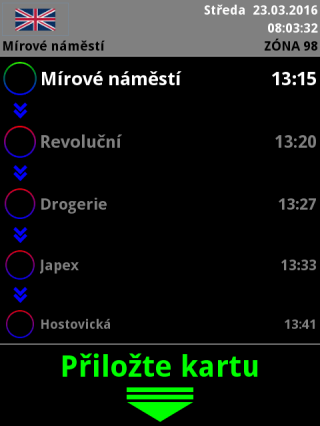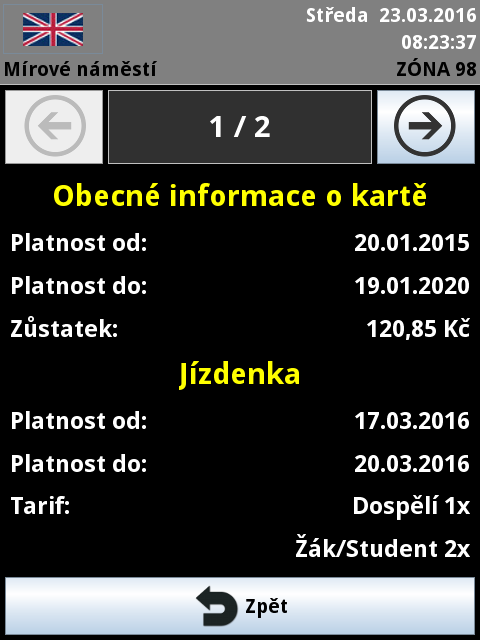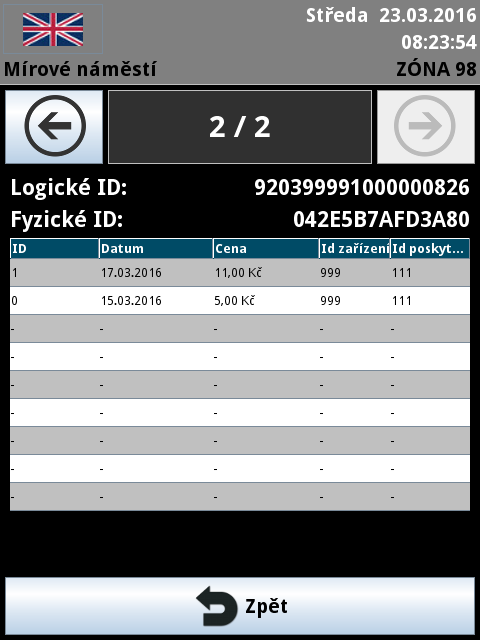Check-in on public transport vehicles
 Check-in on public transport vehicles is based on self-service check-in with the possible sale of tickets at the driver. Check-in (purchase of tickets or proof of subscription) is done using a bank or non-bank contactless smart card with the possibility of printing a ticket. The check-in system is based on the on-board computer EPIS 4.0x and on passenger check-in components - validators and ticket markers. The advantage of this arrangement is a single control unit in the vehicles, which simultaneously performs the functions of both the check-in control unit, the information and communication system control unit and the backoffic communication control unit (BOS).
Check-in on public transport vehicles is based on self-service check-in with the possible sale of tickets at the driver. Check-in (purchase of tickets or proof of subscription) is done using a bank or non-bank contactless smart card with the possibility of printing a ticket. The check-in system is based on the on-board computer EPIS 4.0x and on passenger check-in components - validators and ticket markers. The advantage of this arrangement is a single control unit in the vehicles, which simultaneously performs the functions of both the check-in control unit, the information and communication system control unit and the backoffic communication control unit (BOS).
The principle of public transport check-in
For check-in in urban agglomerations, we have four check-in options:
- Full self-service check-in in the entire vehicle (boarding through all doors of the vehicle) - see Figure 1.
- Self-service check-in only when boarding through the front door with driver control or limited ticketing.
- The on-board computer EPIS 4.0x can check-in passengers for another independent check-in system (see the solution in DP Ostrava), i.e. the driver's terminal displays check-in data from the control panel of the check-in system and vice versa - tickets selected by the driver are sent back to the check-in system for further processing.
- Ticket marker ETM 4.0 - a unit for passenger check-in by marking a paper ticket by printing the traffic data when the passenger enters the vehicle.
For items 1 and 2 we have prepared an optimised variant of the solution, i.e. one that has only one on-board control computer EPIS 4.0x, into which the check-in database is integrated, and a corresponding number of BČK validators type EVK 5.X without or with printer. In this case, there is no need to use an additional control unit for check-in, thus reducing the installation cost. The passenger checks in himself using a contactless chip proprietary or bank card.
The basic wiring of the system is based on components manufactured by us:
- EPIS on-board computers, which simultaneously store a database of transactions and run the passenger check-in application and a firewall for GSM communication or for communication via WiFi in the carriages,
- EVK 5.0 or EVK 5.1 validators enabling the processing of contactless smart cards, including bank cards (validators are subordinate to the on-board computer),
- other components, such as Ethernet switches ECU 08P.x with the possibility of powering the validators directly over the UTP cable with PoE (or PoE according to IEEE 802.3 at), communication unit UCU 5.0 or GSM modem EPG 4.0 with (UMTS or LTE communication).
Connection of the check-in system in the public transport vehicle based on the on-board computer EPIS 4.0x.
In case of ticket sales at the driver's place, it is possible to check-in passengers directly on the on-board computer EPIS 4.0x. The following screens show the status of the check-in system and a sample ticketing screen:


Check-in using BČK or QR codes
We currently offer two sizes of validators for check-in using contactless smart cards (BČK) (bank or non-bank), differing in mechanical design and size of the control display:
- EVK 5.0 x basic validatorwithout printer (small simple version) or EVK 5.1 (complex version).
- the extended version EVK 5.0 xP with printer
The EVK 5.0 validators are homologated for the bank card (meets the appearance requirements of the banking association) and for the Pilsen card (or for the Mariánské Lázně or Karlovy Vary card) and can be integrated for other types of cards of carriers or transport coordinators (open solution). In this case, they contain a card reader that can switch according to the type of card attached. Thus there is only one contactless card reader in the validator. Another type of clearance that validators can handle is QR code clearance. For this purpose, validators are equipped with a reader for QR codes, usually read from mobile phone displays (e.g. EVK 5.1 has one included). Validators can work with different types of FW, which are always developed "to order" for a given user of each card type. For self-service passenger check-in at the front door and controlled by the driver, the transaction database is then shared with the EPIS 4.0x on-board computer.
Passenger check-in scenarios on validators
Using a validator, a passenger can check-in independently in the vehicle. He/she chooses the appropriate ticket and pays for it himself/herself from the card or can have it prepaid with a "coupon". For this purpose, the validator contains several basic operating schemes - main screen, saver, card status, etc. On each page, the language can be switched by an icon in the top left corner of the screen.


Card status screen(s) containing complete card information. So far only the log and electronic wallet statuses. In the future it will also contain coupons and customer profiles.
Classic check-in method - ticket markers
The classical method of check-in is to mark paper tickets when boarding the vehicle, where the marker prints the traffic data and the time of boarding of the passenger on the paper ticket and thus the ticket becomes valid. The passenger marks the ticket himself. For this purpose, two basic types of ETM 4.0 markers can be supplied:
- ETM 4.0 - basic version with Ethernet bus interface
- ETM 4.0I - design for historical compatibility - the communication interface is the IBIS bus
Example of the marking of paper tickets in ETM 4.0I according to the "Technical and operational standards" of IDS JMK, which the marker meets:
Uniform printing of paper tickets in IDS JMK according to "Technical and operational standards".




